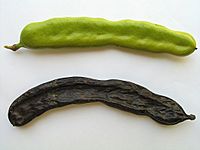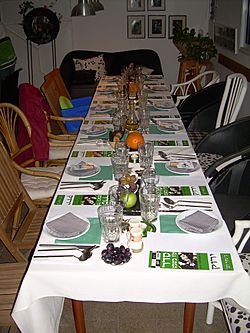Tu BiShvat seder facts for kids
A Tu B’Shevat seder is a special meal and celebration. It honors the Jewish holiday of Tu BiShvat. People often eat many different fruits during this ceremony.
Long ago, people started celebrating this day by eating fruits. This was because the Mishnah, an old Jewish text, called it a "New Year." This made it a good time for a celebration.
Contents
History of the Tu B'Shevat Seder
In the 1500s, a wise teacher named Rabbi Yitzchak Luria lived in Safed, a city in the Land of Israel. He and his students created the Tu B'Shevat seder. It was a bit like the Passover seder.
This new seder celebrated the Tree of Life. This idea comes from Kabbalah, a part of Jewish mysticism. The Tree of Life is a way to understand how God connects to the world.
The Book of the Beautiful Tree
The first book describing this seder was called the P'ri Eitz Hadar. This name means "The Fruit of the Beautiful Tree." The seder helps people feel closer to the Tree of Life. It aims to bring good blessings back into the world.
It uses the idea of "Four Worlds." These worlds are like different levels of reality. They can be compared to parts of a tree: roots, trunk, branches, and leaves. Some Chassidic Jews also eat a special fruit called an etrog on this day.
A Special Prayer
The traditional Tu B'Shevat seder ends with a meaningful prayer. Part of this prayer says: "May all the good sparks that we or our ancestors have scattered be returned. May they become part of the great power of the Tree of Life."
Customary Fruits for Tu B'Shevat

During the Tu B'Shevat seder, it is common to eat many different fruits and nuts. Even if people don't follow all the Kabbalistic traditions, they usually enjoy dried fruits and nuts.
Popular Fruits to Eat
Some very popular choices include figs, dates, raisins, carob, and almonds. Many people also include the Seven Species in their seder. These are seven special foods mentioned in the Torah that grew in the Land of Israel.
According to the book of Deuteronomy 8:8, these seven species are:
Kabbalistic Fruit Meanings
In Kabbalah, the fruits you eat can represent different levels of spirituality. They are often divided into groups:
- Fruits with hard, inedible outsides and soft, edible insides. Examples are oranges, bananas, walnuts, and pistachios. Some people count oranges as fully edible, placing them on the highest level.
- Fruits with soft outsides but a hard pit inside. These include dates, apricots, olives, and persimmons.
- Fruits that are eaten whole. Examples are figs and berries.
Kabbalistic teachings say that eating fruits in this order helps you connect with the Tree of Life. This is the tree God placed in the Garden of Eden. It is mentioned in the Book of Genesis, where Adam and Eve lived after their creation.
As you eat these fruits, you also drink different mixtures of red and white grape juice or wine. You start with white and gradually add more red, until it's mostly red with just a drop of white. This also matches the spiritual journey of the seder.



